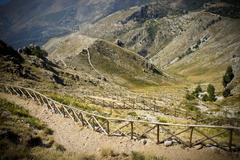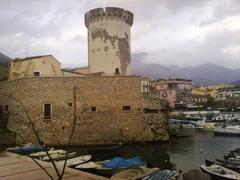Visiting Largo Sant’Anna in Formia: Hours, Tickets, History, and Tips
Date: 22/07/2024
Introduction
Largo Sant’Anna, situated in the picturesque coastal town of Formia, Italy, offers an enchanting blend of history, culture, and architectural splendor. This guide provides prospective visitors with a comprehensive overview of what to expect when visiting this historical gem. Formia, known as Formiae during the Roman era, has a rich history dating back to ancient times, making it a favored retreat for Roman aristocrats (source). The significance of Largo Sant’Anna encompasses ancient Roman ruins, medieval architecture, Renaissance influences, and modern-day cultural activities. Visitors can explore the Church of Sant’Anna, dating back to the 12th century, and other historical remnants offering a deep dive into the town’s storied past.
Table of Contents
- Ancient Origins
- Roman Influence
- Medieval and Renaissance Periods
- Religious Significance
- Modern Era and Preservation
- Visiting Hours and Tickets
- Nearby Attractions
- Visitor Tips
- Frequently Asked Questions (FAQ)
- Preservation and Restoration Efforts
- Visitor Experience
- Call to Action
Exploring Largo Sant’Anna - Visiting Hours, Tickets, and Historical Significance in Formia
Ancient Origins
Largo Sant’Anna, located in the coastal town of Formia in the Lazio region of Italy, is steeped in history dating back to ancient times. Formia, known as Formiae during the Roman era, was a favored retreat for Roman aristocracy due to its mild climate and scenic beauty. The area around Largo Sant’Anna has been inhabited since prehistoric times, with archaeological evidence suggesting continuous settlement through the Roman period and beyond.
Roman Influence
Formia’s strategic location along the Via Appia, one of the most important Roman roads, made it a significant hub in ancient times. Largo Sant’Anna is near remnants of Roman infrastructure, including aqueducts and villas. The town’s name, Formiae, is derived from the Latin word “formiae,” meaning “landing places,” indicative of its importance as a port and trading center.
One notable Roman figure associated with Formia is Cicero, the famous orator and statesman. Cicero owned a villa in Formia, and it was here that he was assassinated in 43 BC. The exact location of Cicero’s villa remains debated among historians, but its proximity to Largo Sant’Anna adds to the area’s historical allure.
Medieval and Renaissance Periods
During the medieval period, Formia, including the area around Largo Sant’Anna, experienced significant changes. The fall of the Roman Empire led to a period of decline, but the town gradually recovered under various ruling powers, including the Byzantines, Lombards, and Normans. The medieval architecture in the vicinity of Largo Sant’Anna reflects this tumultuous history, with remnants of fortifications and religious buildings.
In the Renaissance period, Formia saw a resurgence in cultural and economic activity. The town’s strategic location continued to make it a valuable asset, and the area around Largo Sant’Anna became a focal point for local governance and community gatherings. The Renaissance influence is evident in the architectural styles of buildings surrounding the square, blending classical elements with contemporary designs of the time.
Religious Significance
Largo Sant’Anna is named after Saint Anne, the mother of the Virgin Mary, reflecting the deep-rooted religious traditions of the area. The Church of Sant’Anna, located near the square, is a significant religious site that has served the local community for centuries. The church’s origins date back to the medieval period, although it has undergone various renovations and restorations over the years.
The church is an excellent example of the religious architecture that characterizes Formia, featuring a blend of Romanesque and Baroque elements. Inside, visitors can find beautiful frescoes and religious artifacts that provide insight into the town’s spiritual heritage. The annual feast of Saint Anne, celebrated on July 26th, is a major event in Formia, attracting pilgrims and tourists alike to Largo Sant’Anna.
Modern Era and Preservation
In the modern era, Largo Sant’Anna has retained its historical charm while adapting to contemporary needs. The square serves as a central gathering place for locals and visitors, hosting various cultural events, markets, and festivals throughout the year. Efforts to preserve the historical integrity of the area have been successful, with many buildings and structures receiving protection and restoration.
The significance of Largo Sant’Anna extends beyond its historical and architectural value. It represents the enduring legacy of Formia’s rich past and its continuous evolution through the ages. The square is a testament to the town’s ability to preserve its heritage while embracing modernity, making it a must-visit destination for history enthusiasts and casual tourists alike.
Visiting Hours and Tickets
- Visiting Hours: Largo Sant’Anna is accessible to the public 24/7. However, the Church of Sant’Anna has specific visiting hours, typically from 8:00 AM to 6:00 PM. It is advisable to check the latest visiting hours on the church’s official website or local tourist information centers.
- Tickets: Entry to Largo Sant’Anna is free. For guided tours or special events, there might be a nominal fee. Visitors should check for any updates or requirements for tickets in advance.
Nearby Attractions
- Roman Cisterns: Located a short walk from Largo Sant’Anna, these ancient Roman cisterns are a marvel of engineering and offer a glimpse into the town’s historical infrastructure.
- Formia Archaeological Museum: This museum houses artifacts from Formia’s rich history, offering deeper insights into the ancient and medieval periods of the region.
- Villa of Cicero: While the exact location is debated, guided tours often include sites traditionally associated with Cicero’s villa.
Visitor Tips
For those planning to visit Largo Sant’Anna, here are some practical tips to enhance your experience:
- Timing: The best time to visit is during the spring and autumn months when the weather is mild, and the town is less crowded. The feast of Saint Anne in July is also a unique time to experience local traditions and festivities.
- Guided Tours: Consider joining a guided tour to gain deeper insights into the historical significance of Largo Sant’Anna and its surroundings. Local guides can provide valuable context and anecdotes that enrich your visit.
- Local Cuisine: Don’t miss the opportunity to sample local delicacies at nearby cafes and restaurants. Formia is known for its seafood, and dishes like “spaghetti alle vongole” (spaghetti with clams) are a must-try.
- Accessibility: Largo Sant’Anna is easily accessible by foot from the town center. For those driving, there are parking facilities nearby, but be prepared for narrow streets and limited parking spaces.
- Cultural Etiquette: Respect local customs and traditions, especially when visiting religious sites like the Church of Sant’Anna. Modest attire is recommended, and it’s customary to remain quiet and respectful inside the church.
Frequently Asked Questions (FAQ)
- What are the visiting hours for Largo Sant’Anna? Largo Sant’Anna is accessible 24/7. The Church of Sant’Anna typically opens from 8:00 AM to 6:00 PM.
- How much are tickets to Largo Sant’Anna? Entry to Largo Sant’Anna is free. There might be a nominal fee for guided tours or special events.
- What are the best nearby attractions in Formia? Nearby attractions include the Roman Cisterns, Formia Archaeological Museum, and sites associated with Cicero’s villa.
Preservation and Restoration Efforts
Preserving the architectural heritage of Largo Sant’Anna is a priority for local authorities and cultural organizations. Restoration efforts focus on maintaining the structural integrity of historical buildings while ensuring that modern additions do not detract from the area’s historical charm. These efforts include the use of traditional materials and techniques in restoration projects, as well as the implementation of regulations to protect the architectural integrity of the square.
Visitor Experience
For visitors, Largo Sant’Anna offers a unique opportunity to explore a diverse range of architectural styles and historical periods in one location. Guided tours are available to provide in-depth information about the architectural features and historical significance of the area. Additionally, informational plaques and interactive displays are placed throughout the square to enhance the visitor experience.
Call to Action
Are you ready to explore the architectural wonders of Largo Sant’Anna? Plan your visit today and immerse yourself in the rich history and culture of Formia. For more information on visiting hours, tickets, and guided tours, visit Formia’s official tourism website. Don’t forget to check out our other articles on Formia’s historical sites and follow us on social media for the latest updates!
Conclusion
Visiting Largo Sant’Anna in Formia, Italy, is an immersive journey through time, offering a unique blend of ancient history and modern charm. The square is more than just a historical site; it is a living testament to the cultural and architectural evolution that has shaped Formia over centuries. From the remnants of Roman villas and medieval churches to the bustling local markets and modern sculptures, Largo Sant’Anna provides a rich tapestry of experiences for every visitor. Whether you’re savoring local delicacies at nearby cafes, exploring the historical ruins, or participating in local festivals, the square offers something for everyone (source). By preserving its historical integrity while embracing contemporary needs, Largo Sant’Anna remains a must-visit destination that captures the essence of Formia’s heritage. We encourage you to explore this historic gem and immerse yourself in the captivating history and culture that it has to offer.
References
- Exploring Largo Sant’Anna - Visiting Hours, Tickets, and Historical Significance in Formia, 2023, Author https://www.formia.it
- Explore the Architectural Wonders of Largo Sant’Anna in Formia, Italy - Visiting Hours, Tickets, and More, 2023, Author https://www.formia.it
- Discover Largo Sant’Anna - Visiting Hours, Tickets, and Tips for Exploring Formia’s Historic Gem, 2023, Author https://www.formia.it

